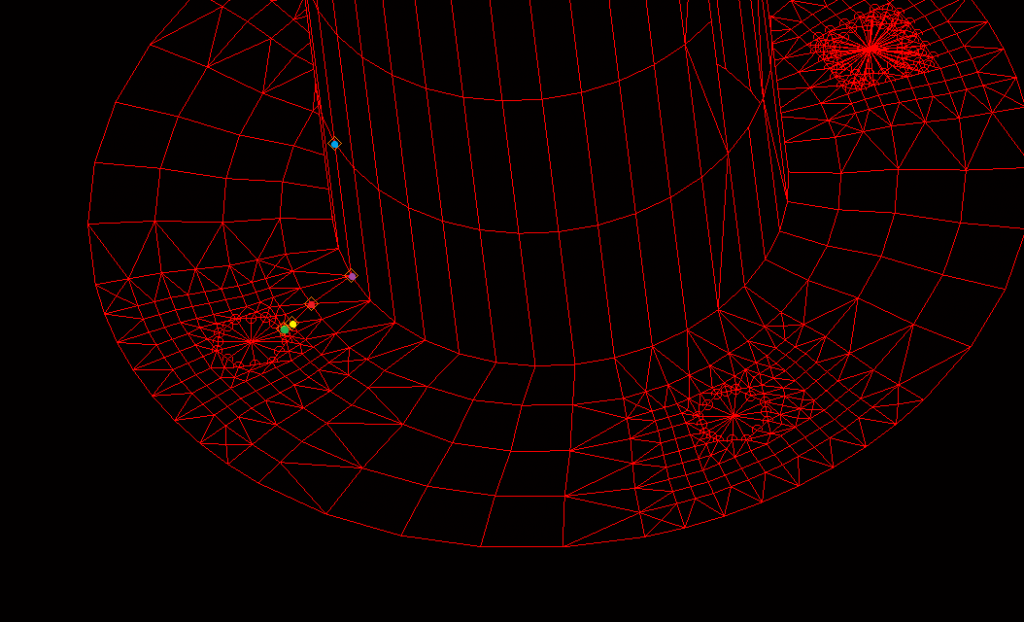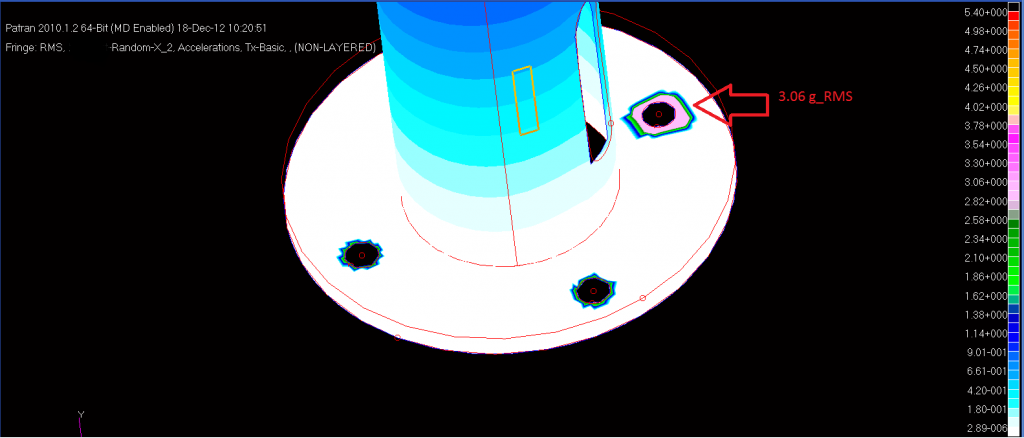ned112
Aerospace
- Dec 17, 2012
- 9
Hi guys, I'm new of the forum even if I've been reading it for a while. I'm working on the Random/PSD qualification of a model for space application, but I'm having some problems on stress results.
The model could be schematized as a small pipe (around 200mm) with two flanges at the beginning and the end, one is crimped to a box the other one has the instruments crimped on them. I'm modelling only the mast with instruments, not the supporting box.
I used mainly shell to model the pipe and the flanges. The constraints have been model using 4 "spiders" of RBE2 elements (one for each of the hole on the flanges) attached to a central independent node (one node for each spider).
The constraints (crimpled so 123) have been applied to the central node, blocking also the constrained nodes around each hole. I tried two different constraints, the first attaches the RBE2s only to the node on the edge of the hole the second type attaches the RBE2s event to the nodes in the sorrounding.

To perform the Random/PSD analysis I use MSC.Random, provide the modal damping rable, select the X axis and release the X constrain.
Then when the analysis is ready I attach the XBD an load the PSD input on MSC.Random and I generate the output. But I'm having very strange results from the PSD of acceleration and the RMS results (stress and acceleration):
-I have peak stress (Shell Sx and Shell VM) in the near vicinity of the constrained nodes (see image below) these stresses decreases increadibly fast, I'm talking of 1 order of magnitude in 2mm!
I'm using SI, so the scale value should be in N/m^2 than scala*10E-06 it Mpa.

-Then I check the PSD sprectrum of the nodes in the vicinity of the constraints, the constrained has the same spectrum of the PSD applied (as it should be), then the closes has a PSD that is 6-7 order of magnitude smaller than the PSD, but increasing the distance this signal grows in intensity.


-I checked the RMS acceleration, and in the vicinity of the nodes I have the exact value of the GRMS value of the spectrum, so I assume the RMS acceleration is normalized in g, that's ok, but is the RMS stress normalized in some means? I really can't explain myself the beahaviour of the stress plot.

Is there any error in modelling or in giving the constraints or in the way I apply the PSD to the system?
Another real strange things is that if I change the thickness of the shell on the flange the stress results don't change, they are exactly the same, even if the changes in the modal analysis are quite evident with an increase in the modal frequencies.
It seams as the very first nodes act as dumper and absorb a very big quantity of energy! But it is a very strange case indeed.
I want to thank everybody how will have the patience to help me solve this problem
Ned
PS: the model will be reviewed and qualified with real test before flying, so don't worry nobody is giving me the complete control of this "problem" neither is the space-flight security in a risk! ;-)
The model could be schematized as a small pipe (around 200mm) with two flanges at the beginning and the end, one is crimped to a box the other one has the instruments crimped on them. I'm modelling only the mast with instruments, not the supporting box.
I used mainly shell to model the pipe and the flanges. The constraints have been model using 4 "spiders" of RBE2 elements (one for each of the hole on the flanges) attached to a central independent node (one node for each spider).
The constraints (crimpled so 123) have been applied to the central node, blocking also the constrained nodes around each hole. I tried two different constraints, the first attaches the RBE2s only to the node on the edge of the hole the second type attaches the RBE2s event to the nodes in the sorrounding.

To perform the Random/PSD analysis I use MSC.Random, provide the modal damping rable, select the X axis and release the X constrain.
Code:
$ Loads for Load Case : msc_random_base_X
SPCADD 2 101 102
RLOAD1 105 106 1 ACCE
LSEQ 102 106 107
SPCD 107 6567 1 1.
RLOAD1 108 109 1 ACCE
LSEQ 102 109 110
SPCD 110 6568 1 1.
RLOAD1 111 112 1 ACCE
LSEQ 102 112 113
SPCD 113 6569 1 1.
RLOAD1 114 115 1 ACCE
LSEQ 102 115 116
SPCD 116 6570 1 1.
DLOAD 103 1. 1. 105 1. 108 1. 111
1. 114
$ Displacement Constraints of Load Set : msc_random_X_unit_accel.101
SPC1 101 1 6567 6568 6569 6570
$ Displacement Constraints of Load Set : crimpled_RBEs_NO_X
SPC1 102 23 6567 6568 6569 6570Then when the analysis is ready I attach the XBD an load the PSD input on MSC.Random and I generate the output. But I'm having very strange results from the PSD of acceleration and the RMS results (stress and acceleration):
-I have peak stress (Shell Sx and Shell VM) in the near vicinity of the constrained nodes (see image below) these stresses decreases increadibly fast, I'm talking of 1 order of magnitude in 2mm!
I'm using SI, so the scale value should be in N/m^2 than scala*10E-06 it Mpa.

-Then I check the PSD sprectrum of the nodes in the vicinity of the constraints, the constrained has the same spectrum of the PSD applied (as it should be), then the closes has a PSD that is 6-7 order of magnitude smaller than the PSD, but increasing the distance this signal grows in intensity.


-I checked the RMS acceleration, and in the vicinity of the nodes I have the exact value of the GRMS value of the spectrum, so I assume the RMS acceleration is normalized in g, that's ok, but is the RMS stress normalized in some means? I really can't explain myself the beahaviour of the stress plot.

Is there any error in modelling or in giving the constraints or in the way I apply the PSD to the system?
Another real strange things is that if I change the thickness of the shell on the flange the stress results don't change, they are exactly the same, even if the changes in the modal analysis are quite evident with an increase in the modal frequencies.
It seams as the very first nodes act as dumper and absorb a very big quantity of energy! But it is a very strange case indeed.
I want to thank everybody how will have the patience to help me solve this problem
Ned
PS: the model will be reviewed and qualified with real test before flying, so don't worry nobody is giving me the complete control of this "problem" neither is the space-flight security in a risk! ;-)
